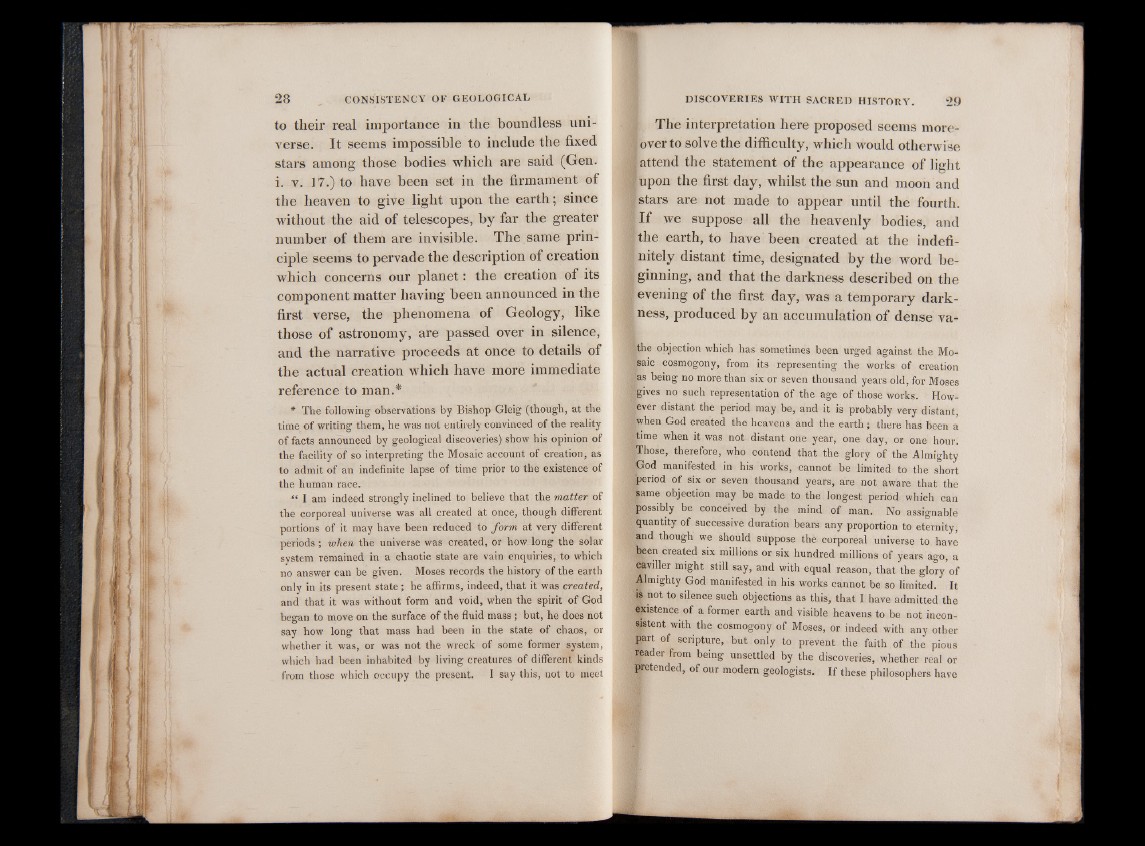
to their real importance in the boundless universe.
It seems impossible to include the fixed
stars among those bodies which are said (Gen.
i. v. 17.) to have been set in the firmament of
the heaven to give light upon the earth; since
without the aid of telescopes, by far the greater
number of them are invisible. The same principle
seems to pervade the description of creation
which concerns our planet: the creation of its
component matter having been announced in the
first verse, the phenomena of Geology, like
those of astronomy, are passed over in silence,
and the narrative proceeds at once to details of
the actual creation which have more immediate
reference to man.*
* The following observations by Bishop Gleig (though, at the
time of writing them, he was not entirely convinced of the reality
of facts announced by geological discoveries) show his opinion of
the facility of so interpreting the Mosaic account of creation, as
to admit of an indefinite lapse of time prior to the existence of
the human race.
“ I am indeed strongly inclined to believe that the matter of
the corporeal universe was all created at once, though different
portions of it may have been reduced to form at very different
periods ; when the universe was created, or how long the solar
system remained in a chaotic state are vain enquiries, to which
no answer can be given. Moses records the history of the earth
only in its present state; he affirms, indeed, that it was created,
and that it was without form and void, when the spirit of God
began to move on the surface of the fluid mass ; but, he does not
say how long that mass had been in the state of chaos, or
whether it was, or was not the wreck of some former system,
which had been inhabited by living creatures of different kinds
from those which occupy the present. I say this, not to meet
The interpretation here proposed seems more-
| over to solve the difficulty, which would otherwise
I attend the statement of the appearance of light
I upon the first day, whilst the sun and moon and
I stars are not made to appear until the fourth.
If we suppose all the heavenly bodies, and
\ the earth, to have been created at the indefi-
| nitely distant time, designated by the word bell
ginning, and that the darkness described on the
| evening of the first day, was a temporary dark-
| ness, produced by an accumulation of dense va-
>the objection which has sometimes been urged against the Mosaic
cosmogony, from its representing the works of creation
as being no more than six or seven thousand years old, for Moses
gives no such representation of the age of those works. However
distant the period may be, and it is probably very distant,
when God created the heavens and the earth ; there has been a
time when it was not distant one year, one day, or one hour,
trhose, therefore, who contend that the glory of the Almighty
God manifested in his works, cannot be limited to the short
period of six or seven thousand years, are not aware that the
same objection may be made to the longest period which can
possibly be conceived by the mind of man. No assignable
quantity of successive duration bears any proportion to eternity,
and though we should suppose the corporeal universe to have
been created six millions or six hundred millions of years ago, a
caviller might still say, and with equal reason, that the glory’of
Almighty God manifested in his works cannot be so limited. It
is not to silence such objections as this, that I have admitted the
existence of a former earth and visible heavens to be not inconsistent
with the cosmogony of Moses, or indeed with any other
® r t of scripture, but only to prevent the faith of the pious
reader from being unsettled by the discoveries, whether real or
pretended, of our modern geologists. If these philosophers have